antiAtlas Journal #5, 2022
Air deportation: (In)visibility, power and resistance
William Walters, Clara Lecadet, Cédric Parizot
Summary: Air deportation is an approach to the expulsion of people that takes seriously the systems of transportation that are central to these processes. This article introduces the idea of air deportation, embeds it in geopolitics and struggles over migration and borders, and argues that this perspective moves us beyond a Eurocentric view of expulsion. Then by introducing the various approaches and format of the contributions making up this special issue, it highlights to what extent documenting air deportation intervenes into a a complex visibility regime in which the ways in which information circulates is very much a part of contemporary forms of government and of migration management.
William Walters teaches politics at Carleton University in Ottawa, Canada. His interests include security, secrecy, migration and governmentality.
Clara Lecadet, is a researcher at the French National Center for Scientific Research. She works on deportation policies, deportees’ grassroots movements in Africa and refugee camps.
Cédric Parizot, anthropologist, Aix Marseille Université/CNRS, IREMAM, Aix-en-Provence. He is one of the initiators and coordinators of the antiAtlas of Borders. His interest includes borders, mobility, space, as well as the relations between research and art.
Keywords: air deportation, borders, migration, civil aviation
antiAtlas Journal #5 "Air Deportation"
Directed by William Walters, Clara Lecadet and Cédric Parizot
Design: Thierry Fournier
Editorial office: Maxime Maréchal
antiAtlas Journal
Director of the Publication: Jean Cristofol
Editorial Director: Cédric Parizot
Artistic direction: Thierry Fournier
Editorial Committee: Jean Cristofol, Thierry Fournier, Anna Guilló, Cédric Parizot, Manoël Penicaud

Bürgersteig by Silke Wagner, 2001-2002. Lufttransa Deportation Class in collaboration with Kein Mensch ist illegal, Hanau. Photo : Wolfgang Günzel.
To quote this article: Walters, William, Lecadet, Clara, Parizot, Cédric, "Air deportation: (In)visibility, power and resistance" published on May 15th, 2022, antiAtlas #5 | 2022, online, URL : www.antiatlas-journal.net/05-walters-lecadet-parizot-air-deportation-in-visibility-power-and-resistance, last consultation on Date
I – Air Transport: A Key Measure in the Deportation of Illegalized People
1 Why should we focus attention on deportation at the level of its forms of coercive mobility? Our argument hinges on the identification of a paradox. On the one hand, systems of civil aviation have become an indispensable backbone of the contemporary regime of immigration enforcement in Europe, North America, Australia, and in other regions as well. On the other hand, the role of aviation in deportation has rarely been considered by scholars as worthy of attention in its own right. Yet, Deutsche Welle (2017) reports that in 2016, 94% of the deportations from Germany were by air. For France, it is reported that in 2018, the French Central Directorate of Border Police (FDCPAF) looked to the skies in nearly 98% of all cases of forced deportations (Assemblée Nationale, 2018: 33). It is true that grasped on a global scale the forcible movement of people by states utilizes all manner of modes of transport. For example, one could mention the infamous railway journeys that eject migrant workers from South Africa to Zimbabwe and onwards (ReliefWeb, 2006), or the bussing of thousands of expelled people across Algeria’s or Libya’s deserts, where they are sometimes abandoned in border towns in Mali, Niger, Chad and Sudan (OHCHR, 2021: 28). Nevertheless, civil aviation has transformed deportation, according it a kind of speed, flexibility and global reach that is historically quite novel. Bruno Latour writes that if you want to understand the role that a given object or technology plays in making our world, try the thought experiment of removing it from the scene (Johnson, 1988: 299). What would the expulsion of people from Germany to Nigeria, or the United States to China look like were the ship the and train the only means of transport available? It is easy to take aviation for granted since nowadays it is so much woven into the fabric of our globalized world. Yet seen in historical perspective its significance and effects on migration control are far from self-explanatory.
Systems of civil aviation have become an indispensable backbone of the contemporary regime of immigration enforcement in Europe, North America, Australia, and in other regions as well
The centrality of aviation to deportation today is evident at other levels, besides the logistics of forcible movements. How often do we see the image of the plane or the airport accompanying media stories of deportation? Here the plane functions as a kind of political synecdoche: the part that has come to symbolize the whole - in this case the whole complex process of immigration enforcement. And if journalists give the plane a certain visual prominence in their mediations of deportation, so too do activists, but in different ways and for different ends. Anti-deportation activism has long identified airlines, departure lounges, flight crews and passengers as strategic points of intervention, forms of leverage for disrupting and making visible the injustice of deportation.
next...
2 However, if aviation matters for activists, this is even more the case for the people who experience deportation most directly. As the testimonies collected by Lucio Cascavilla (this volume) indicate, deportation journeys via plane might usually be faster than the old methods of ship and train but they are often no less violent or traumatic. Yet, this is a different economy of violence, for it is now spatialized around detention centres (themselves often located near international airports), airport buses, and concentrated into the compressed time-space of the cabin, or as research has shown (Alpes, 2015; Lecadet, 2016), played out in airports of transit or on arrival. It is sometimes a violence tied to speed and surprise, as with “unannounced deportations” that aim to seize their subjects with a minimum of advanced notification (Borrelli, 2021; see also Fisher et al 2019). It is often a violence that is mediated by various forms of intervention, ranging from bureaucratic paperwork (Borrelli and Lindberg, 2019), and diplomatic collaboration between states, to the ethico-medical calibration of modes of physical coercion that are applied to people undergoing deportation (Walters, 2017; Makaremi, 2018). These interventions may lend it a degree of legitimacy. But it is a violence nevertheless, a trauma, moreover, that can inscribe bodies and memories. Understanding the nature of the violence of air deportation, how it has been shaped, resisted, and transformed, this is one of the tasks of this special issue.
next...
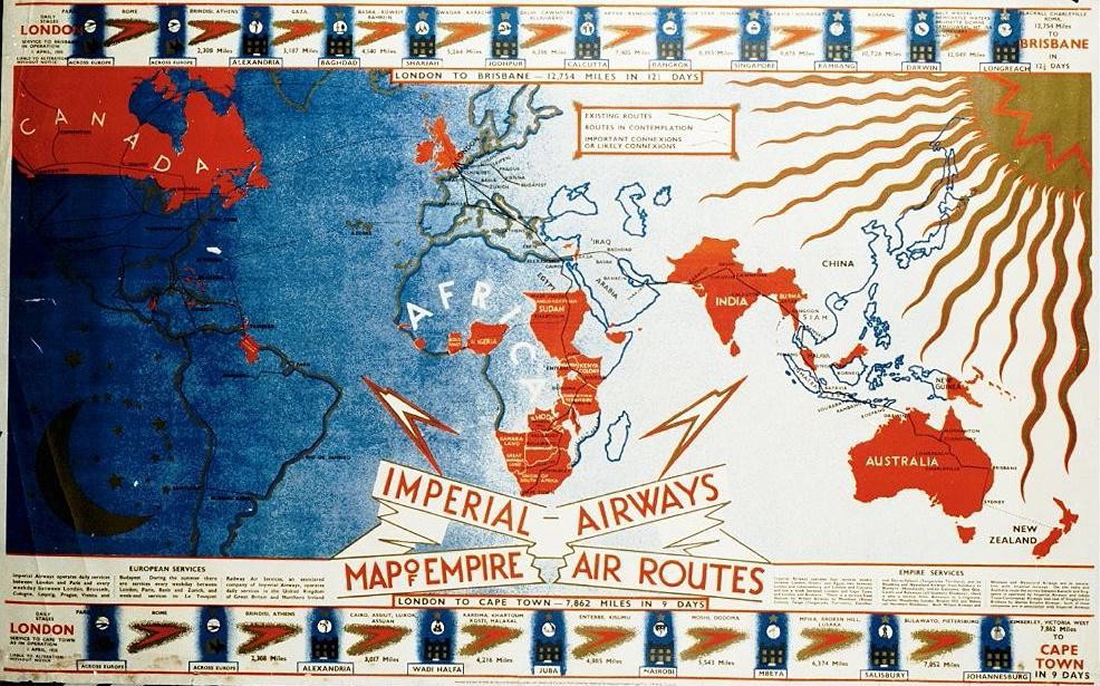
Imperial Airways: Map of Empire Air Routes (c. 1935). Source: in the public domain at https://www.flickr.com/photos/sdasmarchives/19482265491
3 If on the one hand aviation clearly matters for the conduct, the image, the experience and the struggles of deportation, on the other it has been strangely overlooked by a great deal of the scholarship that has emerged in the last two decades. While scholars have explored many dimensions of deportation, immigration enforcement, border controls and migration management at great length, and while we have seen the emergence of important work on carceral geographies and mobilities (Mountz et al, 2013; Moran et al, 2013), the strategic role of aviation in shaping deportation regimes has yet to be examined in any depth. On those occasions when the role of airlines is highlighted, it is usually as one of the many factors that complicate and sometimes frustrate the state’s will to deport (e.g., Phoung, 2005). While there is a rich historical literature documenting the pivotal role of railway networks (Gigliotti, 2009; Blue, 2021; Moran et al, 2012) and ships (Rusche and Kirchheimer, 1939: 53-62; Rediker, 2007) within earlier experiences of carceral and sometimes genocidal population movement, the deportation plane, it would seem, has flown under the radar of the social sciences.
The deportation plane has flown under the radar of the social sciences
Perhaps this neglect of the skies has something to do with time. Compared with the long months or even years a person might spend entangled within the institutional regime of forced removal, including spells in detention, or the much longer period they might live in the shadow of deportability (De Genova, 2002), the time of a plane journey seems relatively brief. Perhaps it is because for some who experience deportation the flight itself is, in fact, not very memorable, and pales in significance compared with the trauma of familial separation and exile. Whatever the reasons for its neglect, in this special issue we call for air deportation to be more fully recognized as a key feature in the borderscapes of migration politics. As such, we seek to build on the small but important range of studies that have zeroed in on the aviation/deportation nexus as a zone of power and resistance, documenting some of its most significant logistical, financial, symbolic and political dimensions (Alpes, 2015; Bhimull 2014; Chappart, 2020; Peutz, 2006, 2010; Corporate Watch, 2013; Fekete, 2011; Lecadet and Walters, 2022; Sambor 2021; University of Washington Center for Human Rights, 2019; Walters 2016, 2017).
next...
4 While we call for a research focus on the aviation/deportation nexus, we stress from the outset that we do not view the plane and its journey as in any way the essence or privileged moment of deportation. To study it in isolation from the regimes of law, policy, space and struggle that shape the broader landscape of migration governance would be to reify the plane. This is not our intent. If we foreground aviation in this special issue it is partly for strategic reasons: we seek to compensate for its neglect in migration scholarship. Yet this is not merely a question of compensating or balancing.
The “discrete moment” of air deportation offers us a different line of approach for representing and intervening in migration politics, one that deserves to be seized.
There is another reason we call for giving air deportation this sustained attention, one that echoes the investigative ethos and attention to the part that characterizes the work of Walter Benjamin. In Passagen-Werk, Benjamin writes of his desire to “erect large constructions from the tiniest, sharply fashioned … materials” and to “discover the crystal of the total event in the analysis of the small, discrete moment” (quoted in Wohlfarth, 2006: 13). Without wanting to open up a discussion about totality here, what we share with Benjamin is the view that large systems and vast processes can be meaningfully interpreted through the prism of concrete specificities.
next...
II – Deportation and the Global Political Order: The Chicago Convention and Post-colonial Geopolitics
5 It is in this discrete moment that a key to interpretation perhaps lies, if we are to understand how deportation by air, whether on flights specially chartered by governments, the International Organisation for Migration (IOM) and / or Frontex, or of course on commercial flights, has become a standardised component of the control and repression measures produced by migration policies. The relative lack of consideration given to air deportation in understanding the current issues, logistics and infrastructure of migration policies is in fact because they have gradually become normal and routine. In the 1980s and 1990s, the organisation of charter flights, in particular from Europe, as well as the presence of expellable immigrants on board commercial flights, was an issue that caused considerable political division and benefited from a certain amount of media exposure, provoking the disapproval and indignation of unions, civil society organisations and ordinary citizens, as well as public figures. Time and the proliferation, publicised or discrete, of these operations have contributed to their normalisation.
Deportation by air is a key to understanding both in global terms and in terms of everyday migration policies
This perhaps explains why it is difficult to understand a phenomenon which cannot, as was the case with deportation carried out in the inter-war period in Europe and during the Second World War, just be ascribed to conflicts between nations, war, or the stigmatisation and mass return of certain categories of people, according to national, ethnic and / or religious criteria. The geographical origin of immigrants subject to deportation, their socio-economic situation and their race are of course inescapable criteria in expulsion measures on a global scale. But unlike deportation carried out during wars or conflicts between nations, deportation by air is nowadays a key to understanding and a reading grid both in global terms and in terms of everyday migration policies. In this respect furthermore, it is certainly not insignificant that certain campaigns and certain protest movements against these policies have used the phrase “war on migrants” (Migreurop, 2006) or the vocabulary of the Second World War – “deportation”, “camps”, “collaboration”, “round-ups” etc. (Lecadet and Walters, in this volume) – to try to warn us of the gravity of the measures routinely applied to foreigners without papers in peacetime.
next...
6 Air deportation certainly tells of a global political order which was gradually imposed after 1945 and in the post-colonial period. Deportations were not simply an addition or an appendix to the workings of civil aviation, any more than they represented a misuse of its purpose. The Convention on International Civil Aviation, known as the Chicago Convention, which was adopted in 1944 and on which the principles of civil aviation are based to this day, recognised the right of countries to control their migration, and is a major document in regulating it on an international level. This connivance between international aviation regulations and the control of migration thus explains why deportation was included in its workings without any close examination. Setting up an international regulatory system for civil aviation had, from the outset, a political aim, to the extent that it would no doubt be artificial to consider airlines – national or private – simply as sub-contractors of governments and institutional political agents. The Chicago Convention helped to redraw world borders after the Second World War and to organise both the division between countries and the movement between them. It had a normative function for countries; it recommended, for example, that they should write the directives of the International Civil Aviation Organisation (ICAO) into their national legislation. It is therefore very probable that integrating the transport of expelled persons into the civil aviation system has always been a process of international collaboration between civil aviation authorities, countries and airline companies.
Integrating the transport of expelled persons into the civil aviation system has always been a process of international collaboration between civil aviation authorities, countries and airline companies
Annex 9 of the Convention, which contains “international standards and recommended practices” that are regularly updated, established a strict protocol for the transport of deportees on commercial flights and recommended cooperation between countries, and also between airlines and escorts. It detailed measures in relation to inadmissible persons and deportees: the way in which the expulsion order should be given to the escort and then to the authorities in the destination country, and the communication of this information to the aeroplane owner at least 24 hours beforehand. Countries had also to abide by the number of deportees authorised by the company on each flight.
Annex 9 of the Chicago Convention also stipulated the obligation on countries of origin to readmit their nationals. It established from then on a protocol which was not only part of the international governance of migration in relation to controlling documents, deportation and readmission, but also made it official and enacted it. The principles set out in the Chicago Convention for the transport of deportees were impressed on countries but were as much the result of their own policies. Thus international civil aviation has for a long time integrated the deportation of undocumented foreigners into its operation by producing a framework of protocols, standards and categories for their transport on commercial flights. The categories of DEPO (deportee), DEPA (accompanied deportee) and DEPU (unescorted deportee) which appear on the travel document, illustrate this transcription of deportation into the regulations of international civil aviation.
next...
7 The geopolitics of air deportation, largely operating from countries of the west (the Americas, Europe, Australia) sit furthermore in historical continuity with, and often retrace, the maps of the first airline routes of the colonial empires (see above the attached map of Imperial Airways, a forerunner of British Airways) (Bhimull, 2014). The post-colonial dimension of air deportation is also part of the current configuration of international power relations. Witness the crushing remark, immediately refuted, made by the American President Trump about the existence of a list of “shithole countries”, which were of no major economic or diplomatic significance to the United States, and to which a great deportation plan could immediately be set in train. Diplomatic links and geopolitical relations between countries, as well as the coordination of logistics for the operation and landing of flights, are in fact important elements in understanding why certain countries accept the return of their nationals, while others are reticent or even refuse publicly the return of their removeable nationals.
next...
8 In order to understand the importance of international geopolitics in the current domain of air deportation, one question, which initially arose from the technicality of diplomatic relations, has emerged in public debate: readmission. In liberal democracies where air deportation is supposed to conform to the rule of law, a consular pass has to be issued by the consulate of the country of origin; this document authorises the readmission of a country’s national onto its territory.
The issue of readmission and of the bilateral agreements which underlie it has been the object of an increasing politicisation as expelling countries put pressure on the countries of origin of immigrants to formalise the principle of readmission in such agreements, and as they have begun to publicise and politicise the refusal of certain countries to readmit their expellable nationals. The growing politicisation of “readmission”, a thorn in the side of deportation policies, has been the subject of various positions taken in the countries, of origin and of residence, of immigrants (Soukouna, 2020; Sylla, Cold-Ravnkilde 2021); from the campaigns against readmission agreements which took place in Mali in 2007 and again in 2016, to the proposition made by the former candidate of the sovereigntist left, Arnaud Montebourg, during the French presidential election of 2022, that immigrants should be banned from sending money to countries which refused readmission. The new forms of cooperation, as well as the tensions which have arisen around the diplomatic issues relating to air deportation, certainly contribute to the redefinition of a “world order” in which the control and repression of movement have become a normal part of politics.
The issue of readmission and of the bilateral agreements which underlie it has been the object of an increasing politicisation
In order to try to counter this normalisation and its integration into the working of liberal democracies, air deportation increasingly became, particularly around the 1990s and 2000s, an issue for protest movements. The publicity images of planes and air transport as emblematic of global travel, from business trips to mass tourism, has been used and misused to denounce deportation and the presence of deportees on commercial flights. There have been campaigns aimed at denouncing the involvement of airlines such as Air France, British Airways and Qantas (see Smith in this volume), which are the flagships of pride and national identity, in repressive state policies on foreigners declared illegal. Airports themselves became a strategic part of protests, in particular to alert passengers to an imminent deportation on a commercial flight, with the aim of creating a chain of solidarity to have the deportee taken off the plane.
next...
An anti-deportation postcard, collective La Chapelle Debout. Photo: William Walters, 2018.
9 From this point of view, planes and airports formed a sort of nexus (together with detention centres and police, legal and administrative systems); they were the engine of new forms of governing foreigners who were declared illegal, at national and international levels, but they were also places which changed the nature of the treatment of foreigners and of the actors and various protest movements concerned with it. Planes and airports were, in other words, both the place and the means of power and of resistance. The fact that air travel became a political issue, both for analysing the way that foreigners were governed, and for understanding the opposition and resistance strategies amongst foreigners declared illegal, sans-papiers collectives, anarchists and associations in defence of the rights of immigrants, also reveals the constant interaction between the mechanisms of power and protest movements. While these movements are often considered as being in a constant state of reaction, response and adaptation to the agenda set by governments, the way in which deportation measures adapted and developed as a consequence of these resistance strategies and protests must also be taken into account. For example, the fact that governments, in their political messaging, liked to refer to “voluntary return” rather than “forcible return”, a distinction seen, however, as illusory and fallacious (Willame 2000, Chappart 2009), may be interpreted as a response to the outcry caused by the use of coercive methods and the violence meted out to deportees on commercial flights. This assimilation of criticism and opposition by state powers should not, however, mask the criminalisation of both deportees and unruly passengers which gradually came to be a part of air deportation.
Planes and airports formed a sort of nexus: they were the engine of new forms of governing
Deportation as a field of study, still marked by nationalist bias in methodology, tends to concentrate on the policies and methods of control, detention and deportation of the deporting countries. Here, we propose, by identifying an airport continuum, to take a transversal perspective that cuts across these policies and the conditions in which they are enforced. We will observe the conditions and the effects of air deportation measures in the countries which deport immigrants, in those through which they transit and in the countries that are their final destination. Drotbohm and Hasselberg (2015) called this travel space the “deportation corridor”, the journey undertaken is often broken up, with different stages, changes of plane, long waits and uncertainties.
next...
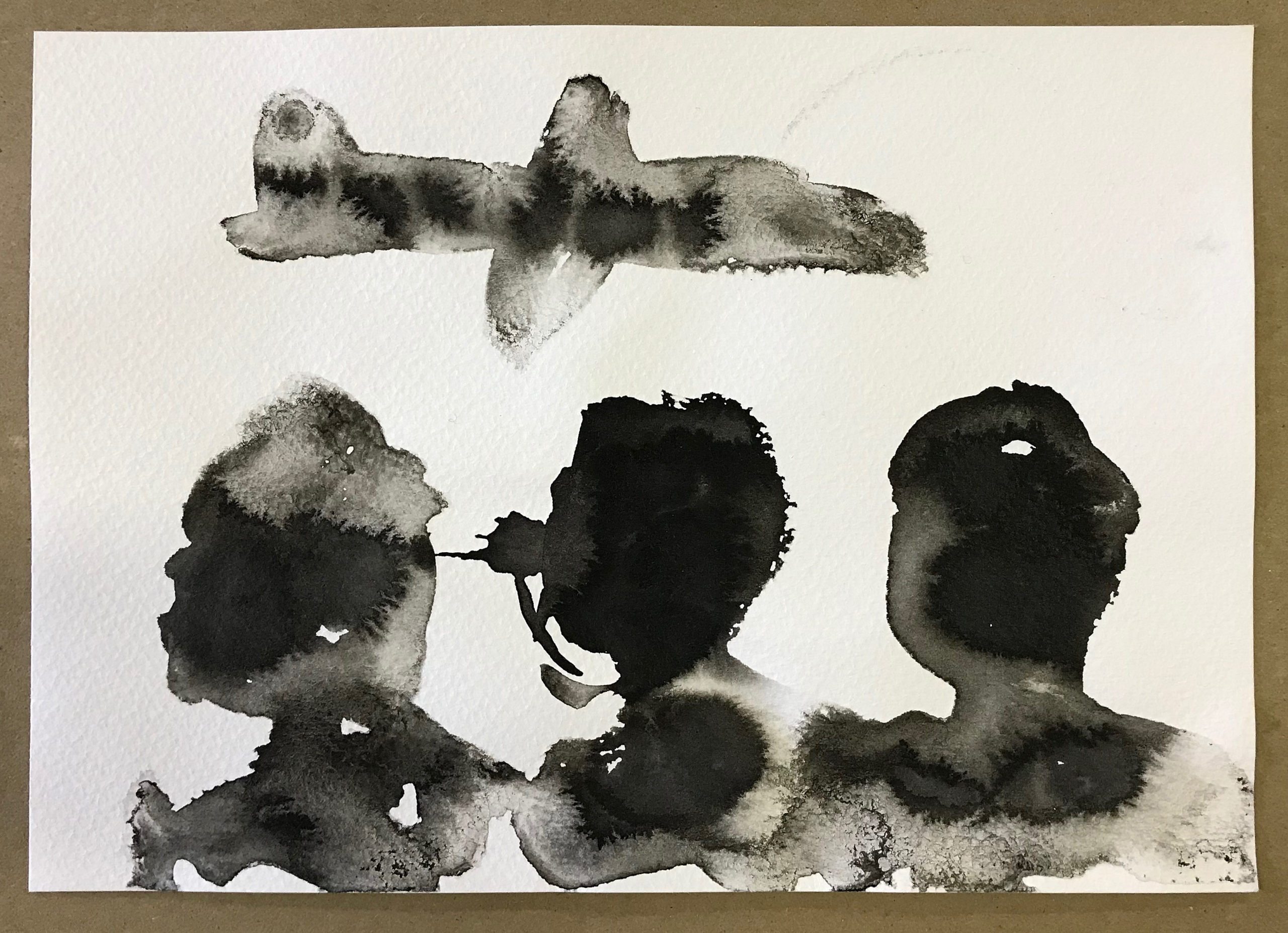
Jenny Polak & Dread Scott, Passes - Watching, black ink on watercolor paper, 9x11in, 2021
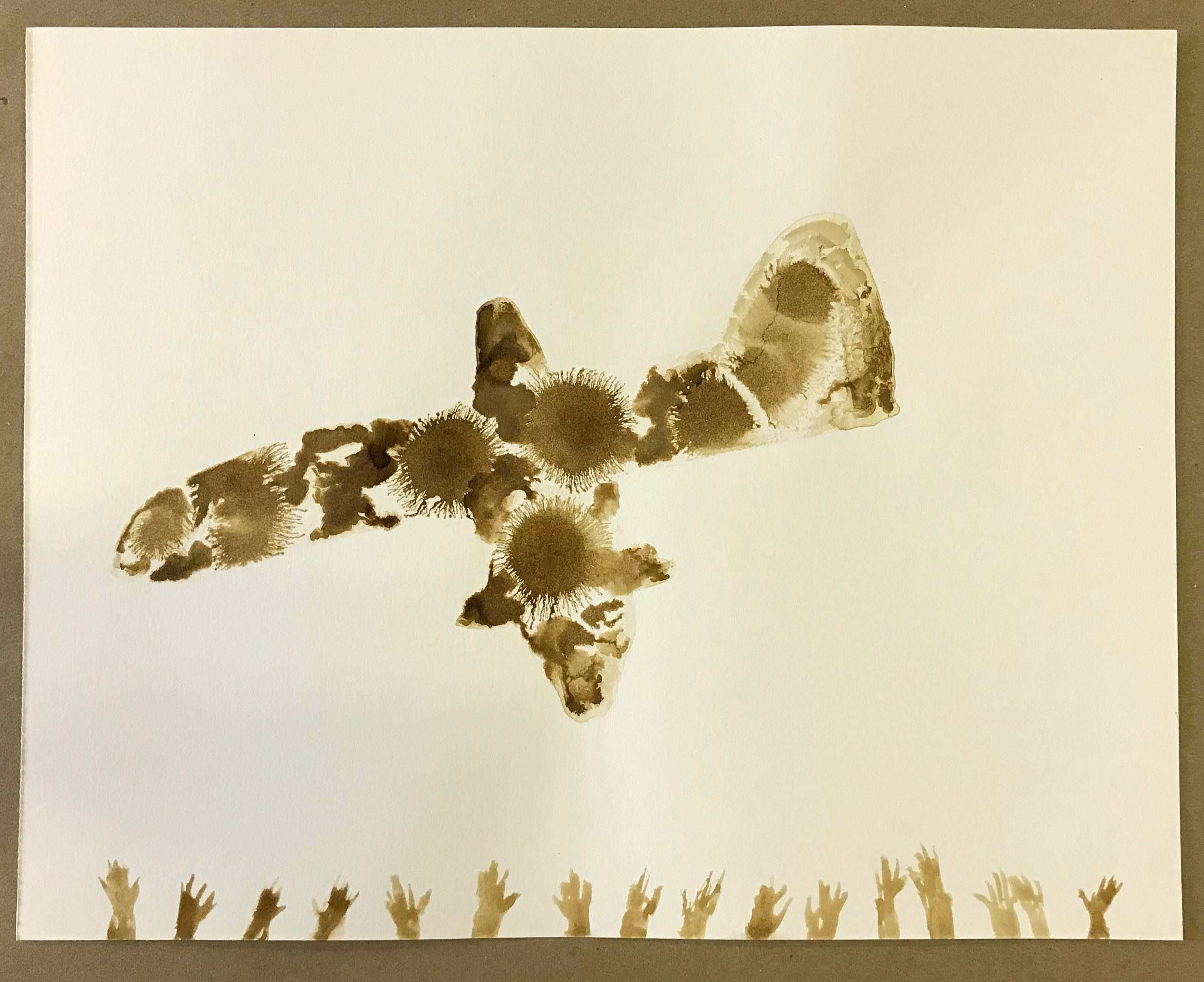
Jenny Polak & Dread Scott, Passes - Waving, sepia ink on watercolor paper, 9x11in, 2021
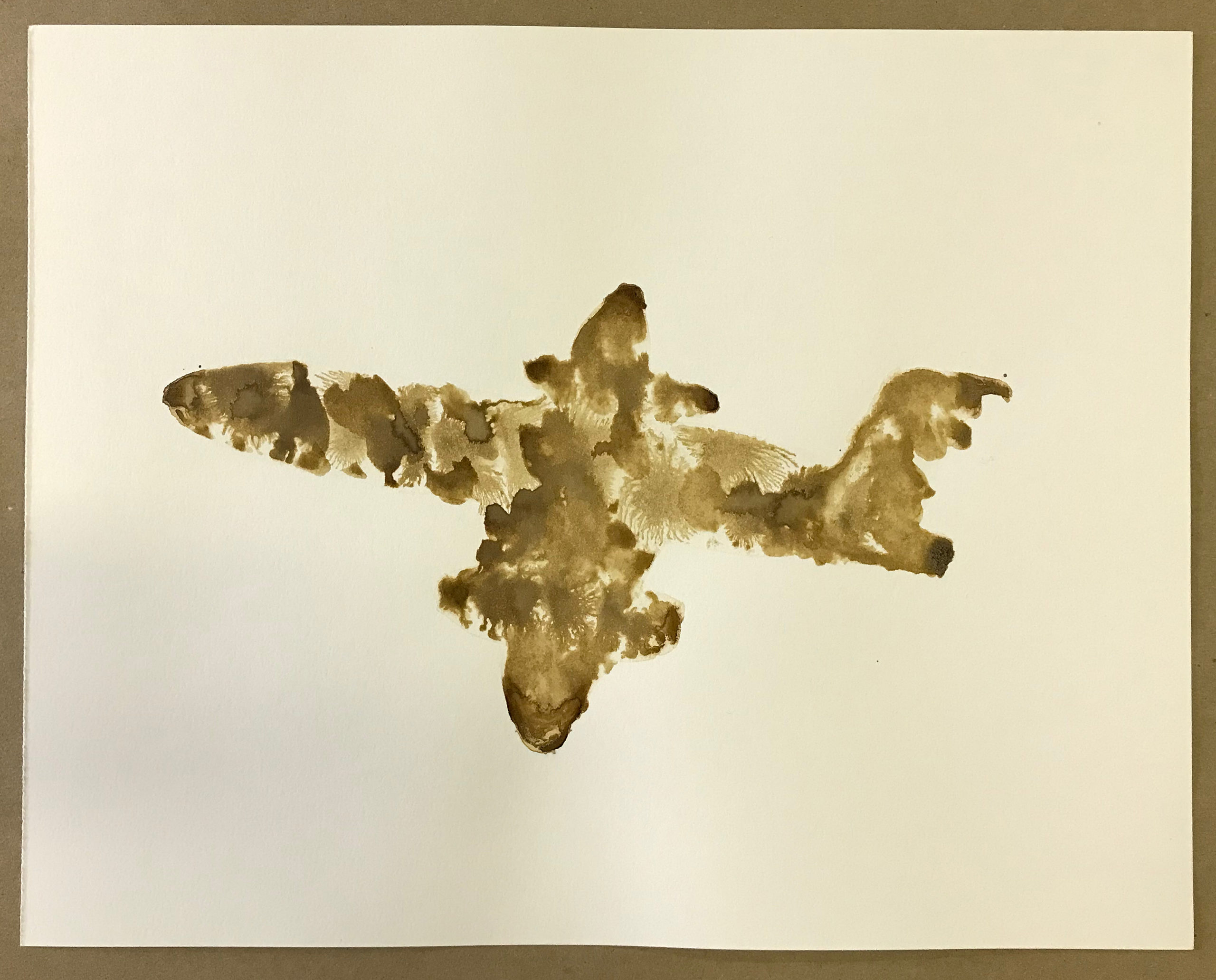
Jenny Polak & Dread Scott, Passes - Leaving, sepia ink on watercolor paper, 9x11in, 2021
10 Taking account of the different stages of expulsion, and in particular of the crucial stage, long ignored by researchers, of the arrival of deportees and their subsequent fate, shows how air transport links different times and spaces which, when brought together, clarify our understanding of the power and the political, social and personal consequences of air deportation. What is the effect of deportation on the measures and procedures in place at the airports of countries to which deportees are returned? To what extent have the policies of the European Union and the United States, advocating migration measures based on increased cooperation with the countries of origins of migrants, – in relation to border controls or the issue of readmission – contributed to transforming the procedures and reception measures for deportees at airports in the countries to which they are returned? This approach requires us to consider the different spaces and temporalities of deportation (Khosravi, 2017 ; Peutz, 2006, 2010), that is, to abandon a view centred on the measures and procedures put in place by expelling countries that is to the detriment of any analysis of the changes brought about by these policies in the countries where deportees land.
A perspective across air deportation routes
The question of subjectivity and the process of political subjectivation has often been hidden in the presentation of deportation measures. A few rare and unpublicised autobiographies have tried to give a first-person account of deportation (Eyezo’o, 2015). But air deportation is also an issue for organisation and politicisation amongst deportees who, in Mali, Togo, Cameroon, Sierra Leone and Mexico, have formed associations for the purpose of asserting their collective existence and finding solutions to issues relating to the reception of deportees and the support, however imperfect, given to them on their return (Lecadet 2016). In Mali and Sierra Leone the involvement of associations has helped to transform airport areas and arrival protocols, by offering deportees support at the end of their journey. One of the challenges here is to try to give a face and a voice to these deported men and women, both in individual accounts of the hardships suffered and in the voice of collectives, which raises the possibility of them becoming political subjects.
next...
III – Taking Part in a Visibility Regime
11 Over and above the analyses and documentation here on air deportation, this issue takes part in a complex visibility regime in which the ways in which information circulates contributes to contemporary forms of government and of migration management. Indeed, given the major political issues involved in air deportation, the public institutions and private enterprises that set it up manage its media coverage very carefully (Walters 2016). The publicity given to these events is, moreover, very rare and is only used to organise targeted forms of communication (Rossipal, 2019). Outside of these circumstances, the authorities prefer to limit the exposure of these deportations so as to reduce the number of local and international protests, as well as embarrassing press coverage (Lüthi et al., Campos Delgado, Zellner, Brewer, Korvensyriä and Osa, Lesbians and Gays Support Migrants in this issue).
The ways in which information circulates contributes to contemporary forms of government and of migration management
The authorities also have recourse to many strategies to reduce and control access to administrative sources. As Sarah Zellner mentions in her study on the role of the European Frontex Agency in organising charter flights, government and European institutions often prolong delays and play on the smallest legal point to delay or restrict the issuing of the administrative documents which the formal procedures ask for. Nor do they hesitate to hide a great deal of information, even sometimes all of it, as well as playing on copyright regulations to restrict transmission and circulation. The data contained in these documents is thus often fragmentary and incomplete. It is even sometimes contradictory from one institution to another. Noting the efforts used by the Mexican administration to restrict, organise and control the transmission and circulation of administrative documents asked for under Freedom of Information legislation, Amalia Campos-Delgado sees these forms of communication, like the documents themselves, as players in a theatrical staging of the media coverage of deportation.
next...
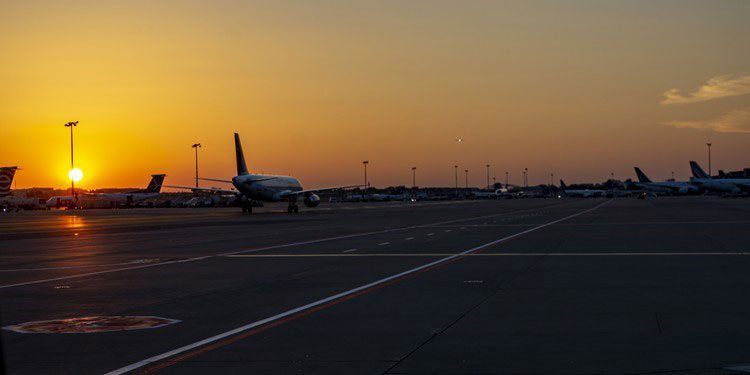
Image from Sarah Zellner's article: photo illustrating a Frontex press release on the first Frontex-supported “voluntary” Joint Return Operation in 2020, Frontex, 2020a. The choice of motif, the sun recalling a happy holiday departure, illustrates the way in which so-called voluntary return is euphemised by the authorities, including Frontex.
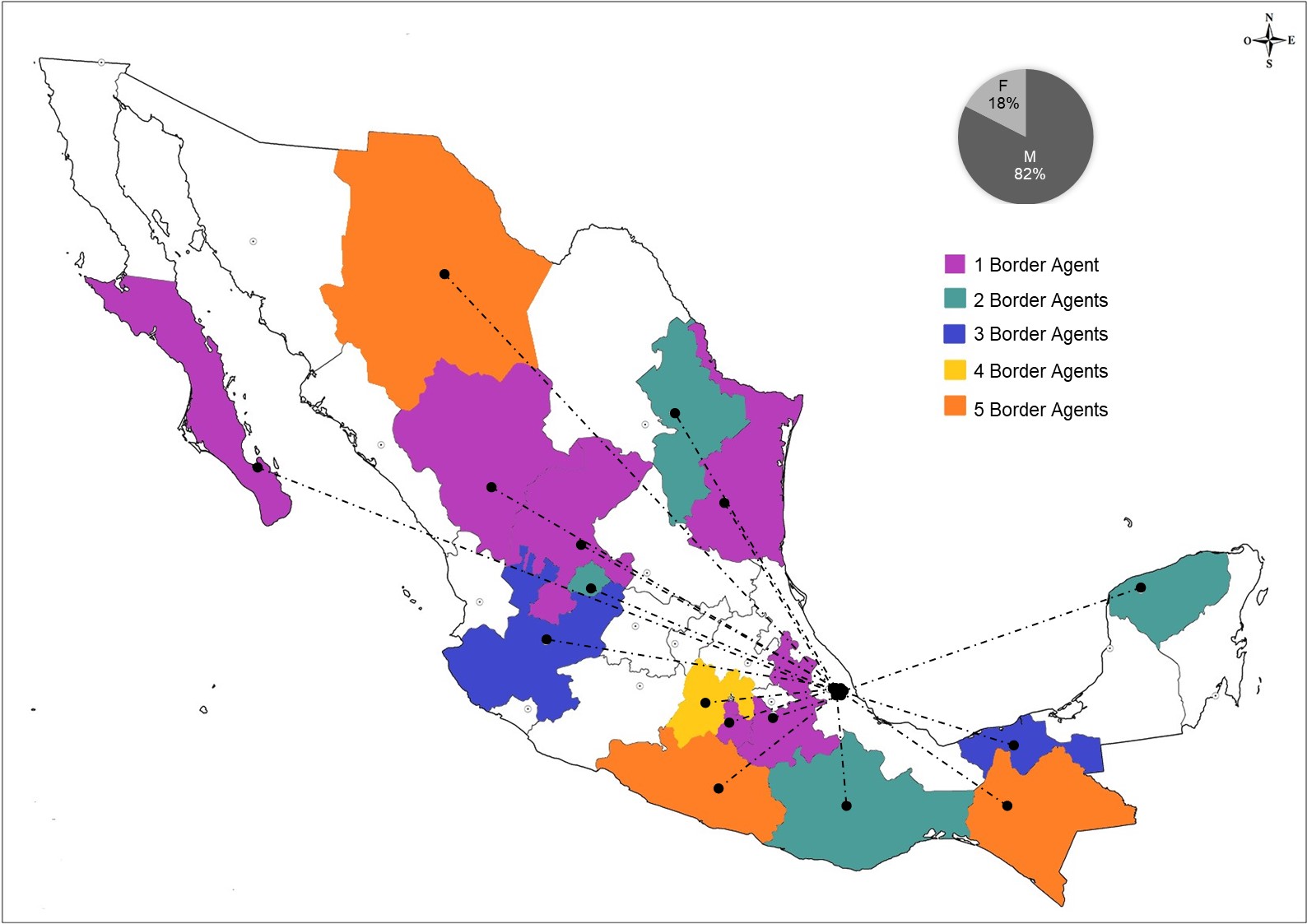
Image from Amalia Campos-Delgado's article: Border agents’ temporary additional duty. Campos-Delgado, 2021. Source: INM-FoI, 2021.
12 When the authorities make no effort to hide their actions, they rely on euphemistic vocabulary and turns of phrase for the violence and suffering caused by deportation. (Zellner, Korvensyrjä and Osa in this issue, Genova, Lecadet, and Walters 2018, Cassarino 2020). This is the case with the expression “voluntary return” which not only hides the sometimes extreme restraint faced by people subject to this kind of procedure (Borrelli 2021), but also tends to present such deportations as a form of “support” in the final stage of a migratory journey (Fine and Walters 2021).
Euphemistic vocabulary and turns of phrase for the violence and suffering caused by deportation
In the field, investigators also face the silence of agents from governmental, intergovernmental or international institutions, and that of the airlines. Extra patience, tact, respect and honesty are thus required if anthropologists or sociologists are to succeed in gaining the confidence of those they talk to and receiving their testimony: airline pilots (Lecadet 2019), senior officials in France, Germany, Belgium or elsewhere in Europe (Zellner), or Greek agents of the IOM (Rozakou).
next...
13 It is thus difficult to meet deportees or those threatened with deportation. Here again, countries and institutions in charge of borders severely restrict access to external observers. This is shown in Maxime Maréchal’s article on the waiting zone at Paris-Charles-de-Gaulle airport (ZAPI), another area for a show of state power. The legal rulings which regulate this area make it very difficult to access. Additionally, no aural or visual recordings are permitted. Researchers are not allowed there either, unless they are working for an authorised non-governmental association. As for police and OFPRA practices, as well as those of interpreters and others working with associations, they tend to constrain and organise translation and communication processes with detainees. Those in the waiting area, liable to deportation, cannot therefore easily speak about their situation and their suffering.
Countries and institutions in charge of borders severely restrict access to external observers
In her article on the organisation of “voluntary returns” by IOM agents at Athens airport, Katerina Rozakou shows how the way in which the migrants’ travel is organised separates them from other travellers, and sometimes even from other deportees. By organising the distribution of the sensible (partage du sensible / Jacques Rancière), these operations become invisible or normalised. Often only occasional traces of these “voluntary returns” can be seen, like the plastic bags given by the IOM to each “candidate” as their only luggage.
next...
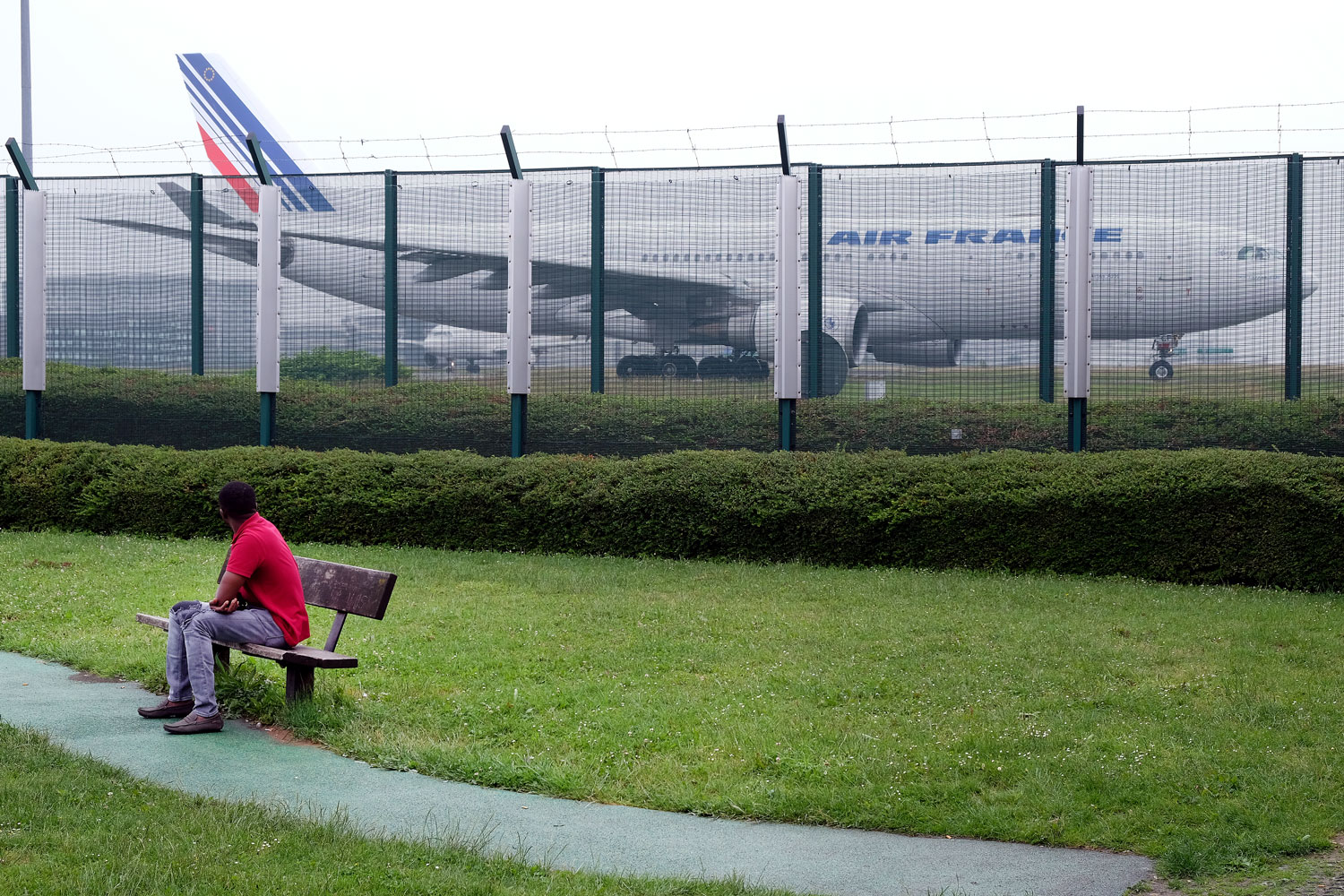
Image from Maxime Maréchal's article: photo J.C. Hanché for CGLPL
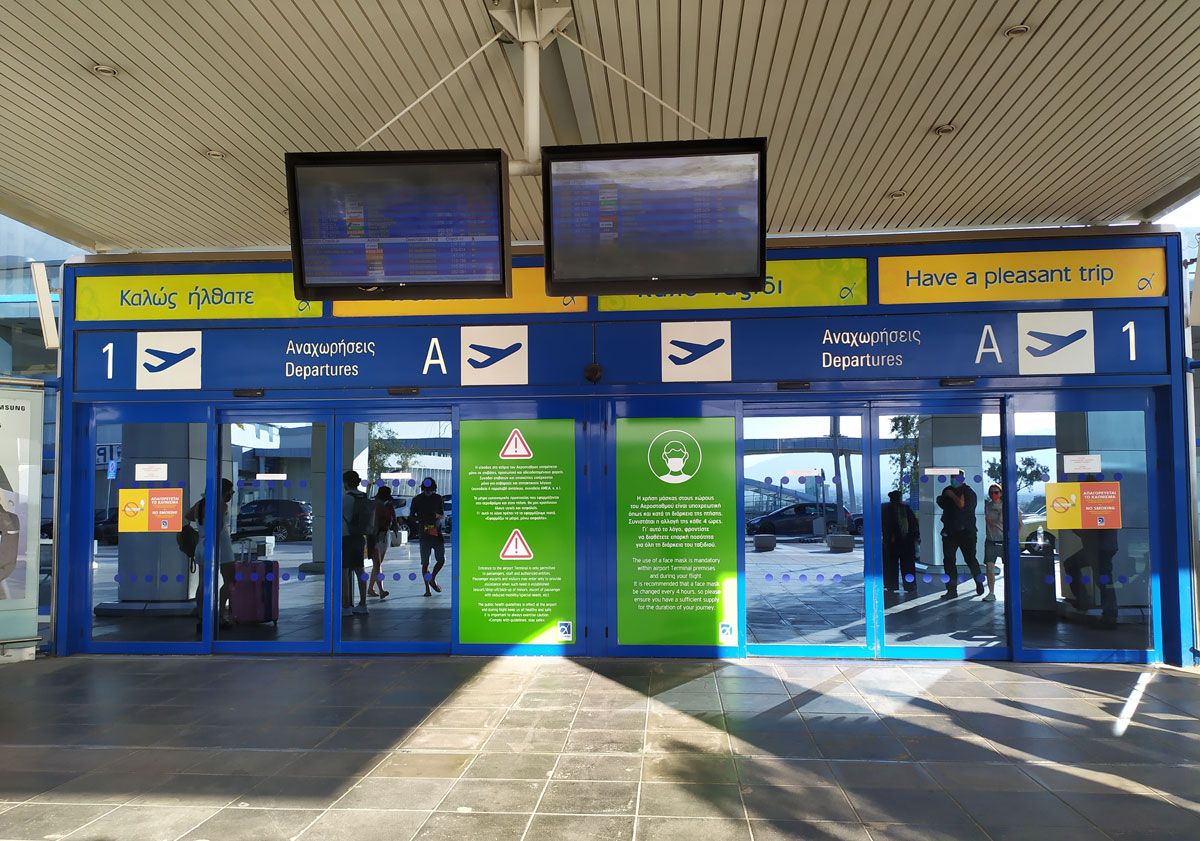
Image from Katerina Rozakou's article: Photo by the author, August 2021
14 The management of the visibility of these operations and the infrastructures which make them possible largely escape state control, however. Activists, journalists, organisations for the defence of human rights and artists often draw attention to the particular forms of violence and secrecy involved in air deportation. They offer a kind of counter-visibility (Walters 2018). Whereas administrative relations and institutional communications tend to reduce deportees to targets, numbers and statistics, the actions of NGOs, militants, artists and journalists restore to them a human presence, a human face.
The visibility regime of air deportation is thus constructed by both its promotors and its detractors
But the effects of their actions go further. A great many contributions to this issue enable us to evaluate the extent to which countries and institutions in charge of these deportations constantly readjust their ways of working in order to get round the resistance offered by those liable to expulsion, as well as other actors (Brewer, Korvensyrjä and Osa, Campos-Delgado, Smith, Zellner). As Barbara Lüthi et al. have emphasised, the visibility regime of air deportation is thus constructed by both its promotors and its detractors (Fischer, 2005). It is constantly in becoming.
next...

Bürgersteig by Silke Wagner, 2001-2002. Lufttransa Deportation Class in collaboration with Kein Mensch ist illegal, Hanau. Photo : Wolfgang Günzel.
15 By choosing to invite artists, activists and journalists to take part in this special issue alongside researchers, we have offered a space to various actors directly involved in monitoring and assisting migrants as well as in active resistance to deportation. Bringing these different contributions together does not merely aim to shed light on different points of view, different analytical scales or approaches. By showing the gaps between the ways in which the different actors are involved, we intend to experience different editorial formats through which it is possible to address, analyse, appreciate and so intercede in this specific practice of migration control. In the same way, we intend to bring our readers to move between different spaces (textual and sensitive), different expressive registers (academic, literary etc.) and different kinds of action (research, journalism, militancy etc.). This special issue will show, furthermore, that academics are far from being in a dominant position in research and investigation into this question.
By showing the gaps between the ways in which the different actors are involved, we intend to experience different editorial formats through which it is possible to address, analyse, appreciate and so intercede in this specific practice of migration control
Certain authors have, moreover, taken full advantage of the editorial possibilities offered by the antiAtlas journal. This is the case of the militant group Lesbians and Gays Support the Migrants who here report on the protest campaign launched in 2019 against the involvement of British Airways commercial flights in the deportation of migrants, initiated by the UK’s Home Office. Principally based on the wealth of iconography assembled in the course of that campaign, this article is more sensory than textual. Readers can choose their own way around it and resort to their own interpretation to give meaning to the campaign and the issues it raises.
next...

Image from Lesbians and Gays Support the Migrants' article: Letter by an Angry Dyke.
16 Other articles move in a very rich and stimulating way between a text that combines experiences with analysis, and documentation that includes many photos, videos, diagrams, maps and administrative documents. The contribution by the researcher and militant Helen Brewer covers her experience of an operation organised in 2017 on the tarmac at Stansted airport, to prevent the departure of a Titan Airways charter flight to Nigeria and Ghana. By presenting original, rare and extremely valuable documentation, this article is an actual, visual archive. In addition, the author questions the potential and limits of the direct action used by certain militant groups, in order to consider the future of anti-deportation resistance in the United Kingdom.
Aino Korvensyrjä and Rex Osa discuss the monitoring of deportation as another form of resistance to expulsion policies. They reflect on the challenges posed by militant observation and by the documenting of these practices in Germany after 2015 and in post-deportation situations in Nigeria. For these authors, monitoring must be mobilised to call into question exclusion and state violence. This must not simply mean public reports but should equally involve work based on self-organisation and action by deportees. Aino Korvensyriä and Rex Osa also state that the claim to political neutrality made by certain journalists, researchers and NGO volunteers is not tenable. In the face of migration policies, any movement is not only political, but also relates to a certain vision of society. In their view, it is not therefore a question of whether we want to be political or not, but in what kind of political system and society we want to live.
The article by Clara Lecadet and William Walters aims to retrace the history of anarchist collectives in France in the 1990s and 2000s. It shows how anarchist action against the “deportation machine” was based on a materialist analysis of the real mechanisms of this oppression, a systematic identification and targeting of the actors contributing to the construction of deportation – from the companies building detention centres to the NGOs which, by taking part in such measures, offered legitimacy to their existence. Anarchist movements on new issues were nevertheless a part of the historical matrix of anarchism as it developed in the 19th century, and its aim of overthrowing the state and capitalism. The “deportation machine” is the hook on which to hang a critique and a struggle for a project of radical change in society. Moreover, the treatment dealt out to foreigners who are declared illegal is just one thing among many others which reveals social insecurity, and a society of surveillance and incarceration.
next...
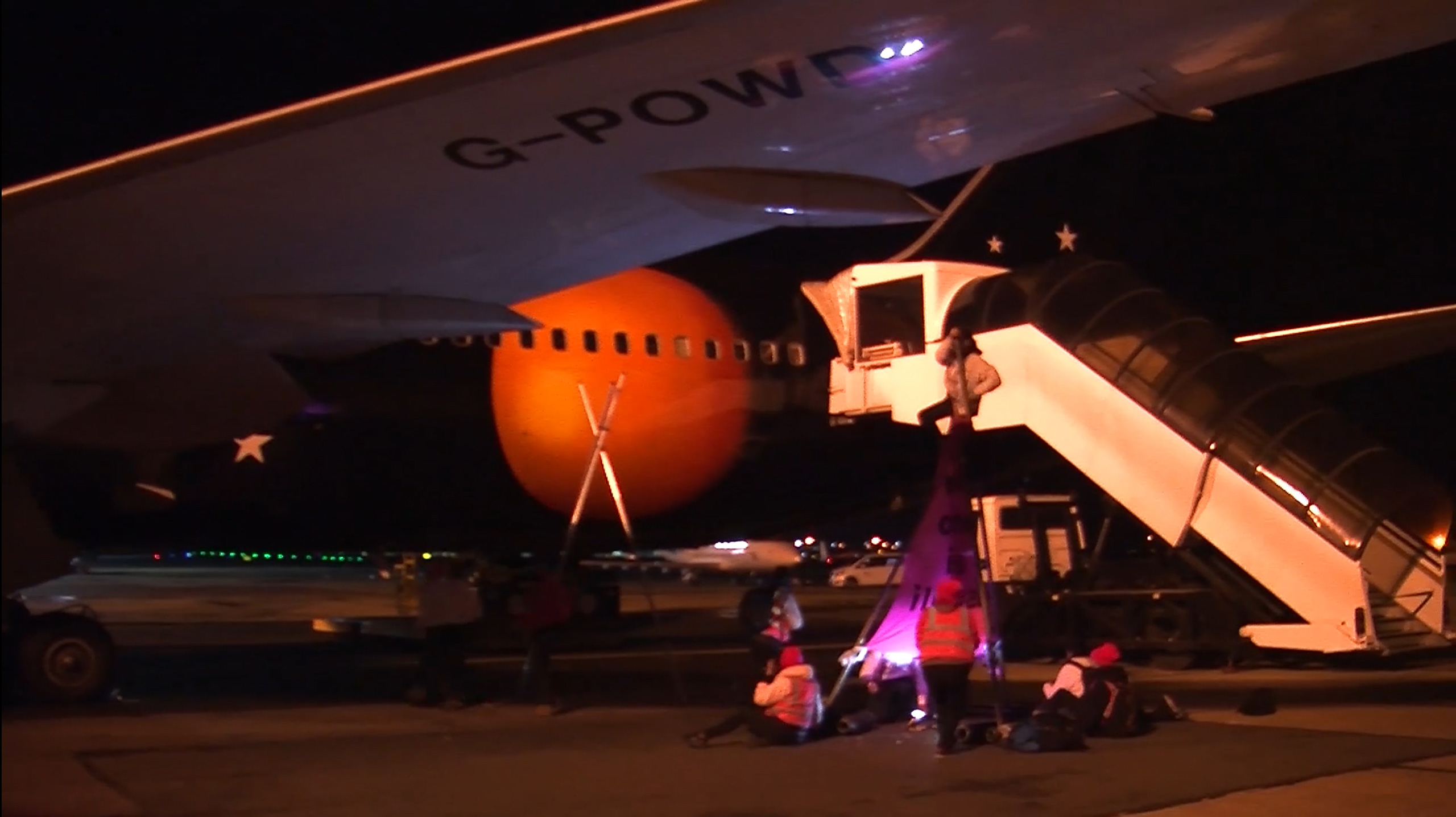
Image from Helen Brewer's article: Fig 1: Video screenshot showing the direct action to stop a charter flight from leaving to Nigeria and Ghana on March 28 2017 at Stansted airport.
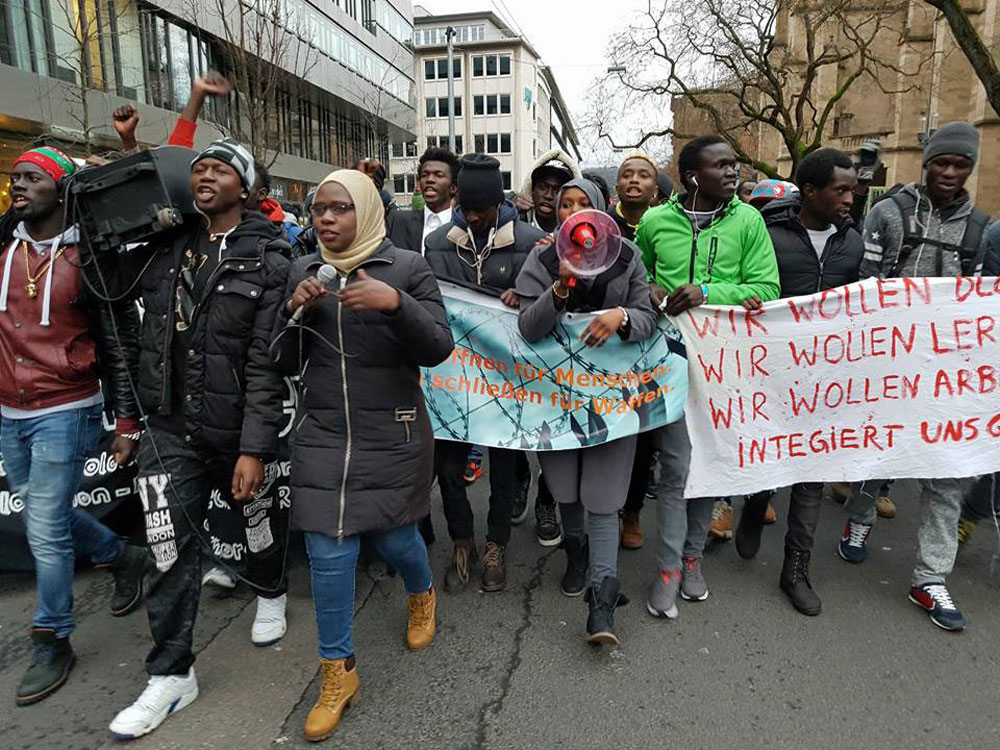
Image from Aino Korvensyrjä and Rex Osa'article: Gambians protesting in Stuttgart against planned deportations, December 2017. Photo: Rex Osa / Gambian community.
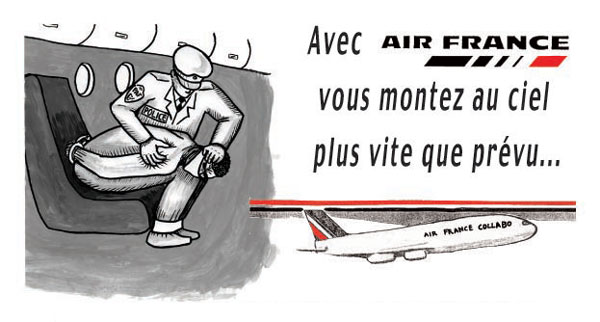
Image from Clara Lecadet and William Walters's article: Collectif Anti-Expulsions, October 2003 (Excerpt), Source : pajol.eu.org
17 The contribution by Barbara Lüthi, Friederike Kretzen and Marianne Büttiker continues this questioning by addressing the case of “Black Autumn Action” (Aktion Schwarzer Herbst) organised in Switzerland in the autumn of 1985, to deport 59 migrants to Zaire and Angola. Through a subtle mixture of historical analysis by Barbara Lüthi, literary pieces by the writer Friederike Kretzen and sketches by the artist Marianne Büttiker, this text deliberately blurs registers. Are we reading a historical study? Are we involved in a personal and thus individual questioning of deportation? The authors do not answer this question; they leave the readers to find their own reply. This article does not therefore have simply a textual or an informative rationale, it goes beyond. The point is not simply to signify, but also to call on readers themselves to reflect on their relationship with deportation and on the implications of these migration control practices on our societies.
The point is not simply to signify, but also to call on readers themselves to reflect on their relationship with deportation
Through a different, but equally effective process, Angela Smith also intends to step to one side of conventional academic writing. Using in-depth research and a particularly rich iconography of protests and deportation practices in Australia, she presents a text in an original format. Rather than choosing to build an argument in a conventional, linear and incremental format, this researcher invites readers to navigate three successive but interconnected accounts. Firstly, that of the Australian legal case to rule on the “expellability” of two men: a Kamilaroi born in Papua New Guinea and a Gunggari born in New Zealand but with family connections to Aboriginal Australians. Then comes the description of recent developments in the Australian “deportation archipelago” which stretches from Australia to New Zealand, and includes offshore detention sites from Christmas Island to Nauru, via Port Moresby and Manus Island in Papua New Guinea. And finally there is the history of the national airline, Qantas.
Presented one after the other, these accounts examine the connections and continuity between stories from different times and seeming to involve different issues. Angela Smith thus shows that in a settler colony like Australia, the use of any kind of forcible movement from or within this territory raises questions about belonging, possession and sovereignty. In fact, in a country in which sovereignty has never been surrendered, attempts to deport people from First Nations inevitably bring to mind colonial forms of dispossession and rejection. All the more so since in Australia the expulsion of Indigenous populations has a long history in the process of building the state, and remains a current measure for restating its presence and its authority.
next...
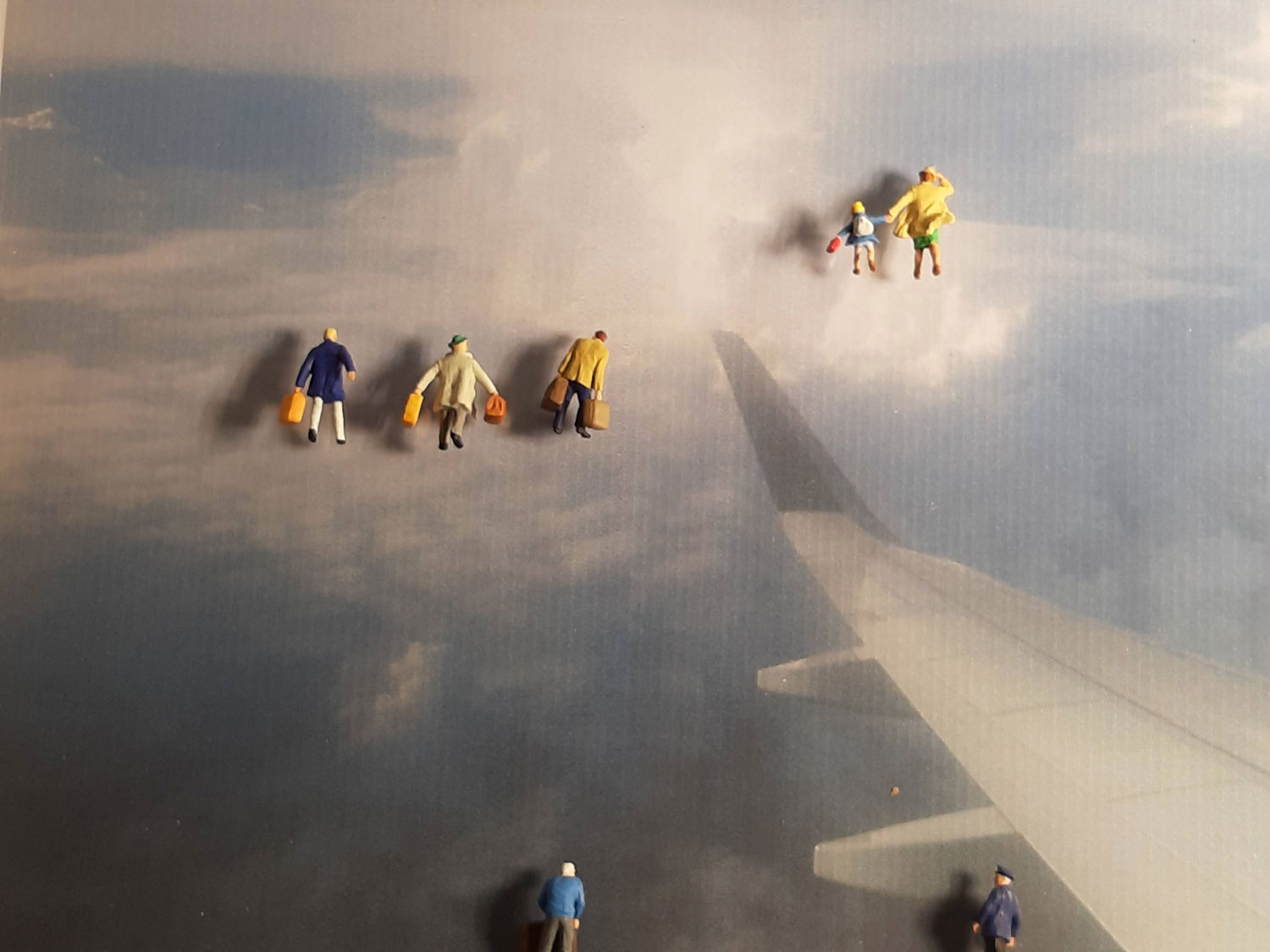
Image from Barbara Lüthi, Friederike Kretzen and Marianne Büttiker's article, by Marianne Büttiker.
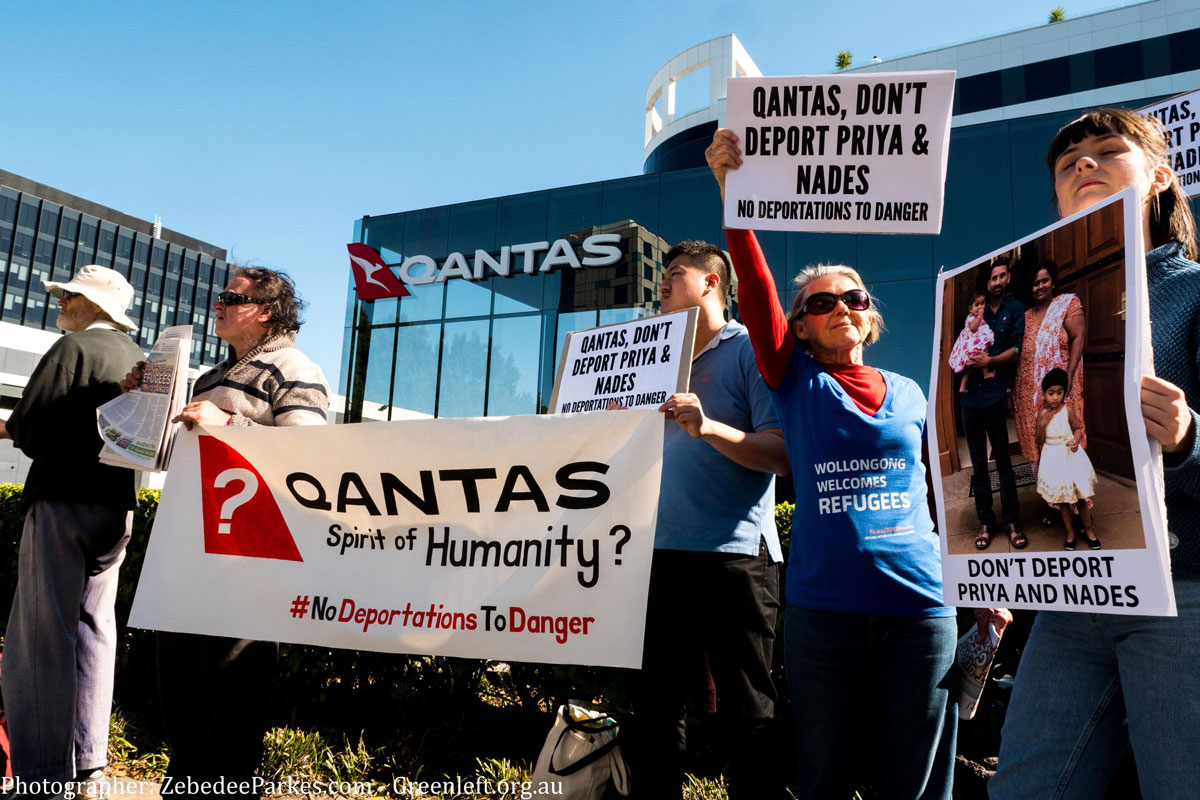
Image from Angela Smith's article: Protesting against ‘deportations to danger’ outside the Qantas office. Photo: Zebedee Parkes
18 If other contributions to this issue are less rich in iconography, this is not because the researchers have a more limited access to this world, or that it is less visible to them, but rather because they approach it differently and rely on other forms of involvement, other forms of reporting and above all on other modes of investigation. Whereas artists and activists try to disturb the deportation process to produce experiences (Caillet 2019) and so make them visible to the greatest number of people and raise questions, other contributors have made an effort to use investigation methods based on less intrusive observation and listening; the aim being to avoid changing in any significant way either the behaviour of those they speak to or the processes they decipher.
Unpublished tables, maps and diagrams add significantly to the archives on deportation in Europe, Oceania or North America
Additionally, through the compilation and analysis of numerous administrative documents obtained through formal requests, unpublished tables, maps and diagrams add significantly to the archives on deportation in Europe (Zellner), in Oceania (Smith) or in North America (Campos-Delgado). The lack of iconography in these articles, as well as the need to reproduce maps and diagrams from their originals, in fact testify to the obstacles that researchers met with in collecting visual or aural records, as well as the opacity which the authorities try to maintain around air deportation. This difficulty in obtaining access and documentation gives an interesting indication of the workings and malfunctions of control measures set up by countries and the institutions involved in deportation (Kalir et al. 2019).
next...
19 This relative lack of iconography does not prevent the authors from putting forward interesting and significant links between their texts and the few images they have managed to gather together. So, some exploit the gap between, on the one hand, rich and full ethnographic descriptions that immerse the reader in the field, and on the other, the absence of iconographic or audio documents. The few elements that they have chosen to retain are used less as illustrations and more as photographic negatives, as they underline the impossibility of capturing the traces left by deportees or by those awaiting a decision, whether in the visual (Rozakou) or sonic landscapes (Maréchal) of airports. This issue thus offers, much more than counter-visibility, a practical and experiential reflection on the material conditions of air deportation and on the many ways of making it and its effects visible and audible.
The practice of air deportation and the infrastructure that enables it are implemented across force fields
This issue will also contribute to an understanding of the extent to which the practice of air deportation and the infrastructure that enables it are implemented across force fields. Even if the relationships between these forces are fundamentally asymmetrical, the institutions in charge of deportation always have to adjust their practices to acts of resistance by deportees, to the reactions of passengers, to demonstrations and action by militants and non-governmental organisations.
These different forms of resistance have, moreover, considerable repercussions on the workings of deportation infrastructure. In addition to the use of charter flights rather than commercial flights, the authorities have been led to move their operations to some airports rather than others, or to schedule them outside busy times etc. Helen Brewer explains that in the United Kingdom the actions of anti-deportation collectives have sometimes forced the authorities to transfer charter flights to military airports. Aino Korvensyrjä and Rex Osa emphasise the fact that engineers setting up biometric databases, financed by the European Union, in Senegal and Sierra Leone tried to create a digital identification system that would work around the protection strategies developed by activists and local communities. So the tactics of one side go hand in hand with those of the other.
next...
20 But the repercussions of acts of resistance are felt well beyond the infrastructure of deportation. Aino Korvensyrjä and Rex Osa note that recent efforts to mobilise public opinion in Germany put a brake on the attempts by some legislators to criminalise acts of solidarity. Likewise, Helen Brewer’s article shows how contemporary forms of resistance in the United Kingdom are a continuation of other forms of protest, for example in relation to climate change. These actions are all the more closely aligned since each one opens new horizons and affects future action.
But the repercussions of acts of resistance are felt well beyond the infrastructure of deportation
Such resistance and monitoring in the face of air deportation really contributes to the reconfiguration or the emergence of new collectives in the societies in which they operate, whether this be in the countries which organise them, in those to which the deportees are sent, or on a transnational scale. Aino Korvensyrjä and Rex Osa thus show the links developed between resistance practices in Germany, Nigeria and other African countries. Clara Lecadet observes a similar dynamic between France and Mali (Lecadet 2016), as well as between France and Sierra Leone, by putting together video interviews with members of the Malian Association for Deportees, a pioneering association in bringing together and organising deportees, created in Bamako in 1996. The accounts and videos collected and presented by Lucio Cascavilla complete this documentation by stressing the singularity of the experiences of the deportees who organise and benefit from the support of associations founded on, and claiming the principle of, self-organisation; they demand in fact that those who are “primarily affected” should be able to reappropriate the condition assigned to them and to fight against the policies that assail them.
next...
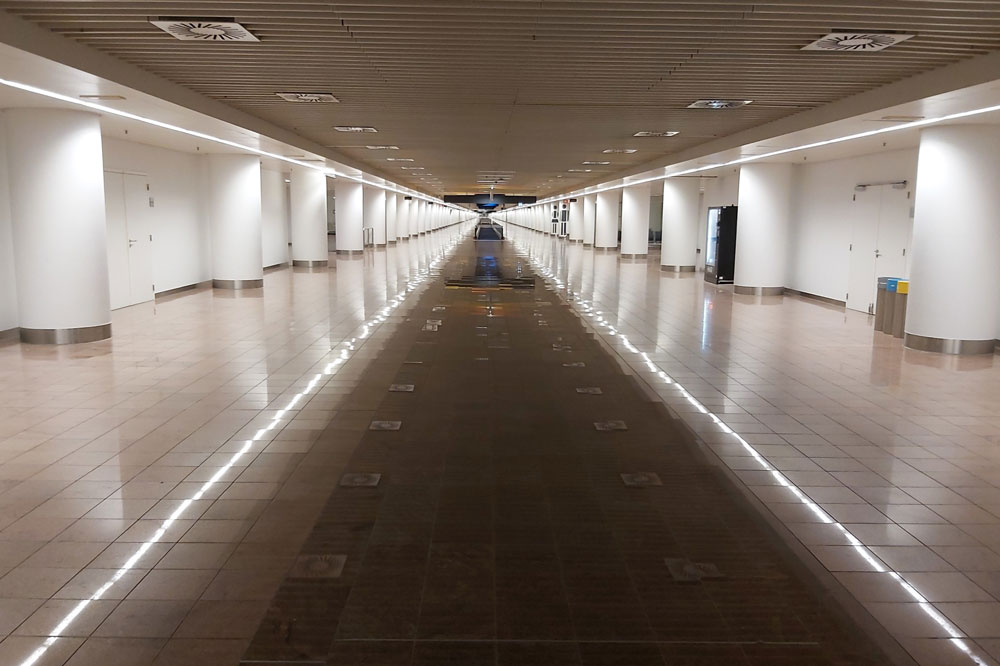
Image from Lucio Cascavilla's article: Photo by the author.
21 But these power relationships do not only operate between the state and civil society, they are also used at a diplomatic level. In accordance with the readmission agreement signed between the two countries, Tunisia refuses to accept specially organised deportation flights from France. When France wants to deport Tunisians, therefore, it has to turn to “joint return operations” organised by other European countries with the support of the European Frontex agency (Zellner). Conversely, it was to show Donald Trump its commitment to cooperating in the fight against migration deemed illegal that the Mexican government thought it appropriate to organise and publicise the deportation in October 2019 of 311 Indians on a charter flight (Delgado). And Frontex plans its activities and its support to the different countries of the European Union in order to respond not only to the demands for efficiency and productivity imposed by the European Commission, but also to the pressure exerted by those funding Frontex (Zellner).
Deportation infrastructures evolve
In force fields, deportation infrastructures evolve. By analysing the development of the assistance offered by Frontex to the countries of the European Union in organising charter flights, Sarah Zellner illustrates this dynamic over the last two decades. These changes are all the more difficult to follow since they involve so many actors. Indeed, the Europeanisation of air deportation through joint charter flights between different countries has brought some extremely complex measures to light. They become fundamentally polymorphous and outsourced just as the process of border control is itself externalised.
Amalia Campos Delgado thus mentions the close connection between the use of Mexican laws and migration practices with the border strategy of the United States, bringing to light integrated systems of border control. The deterritorialization and manipulation of the air deportation practices which she describes are part of a displacement and a wider spread of US border controls into the countries of South and North America which several works have highlighted (Hiemstra 2019; FitzGerald 2020; Menjívar 2014). This was also what Aino Korvensyrjä and Rex Osa showed by mentioning the crucial role of embassies and consulates in non-European countries in carrying out deportations, in identifying undocumented migrants and issuing travel certificates.
These kinds of cooperation do not only modify borders, they also contribute to the creation of new spaces. It is quite possible to talk about integrated control routes and corridors (Campos Delgado) or shared deportation (Walters, 2017). Sarah Zellner demonstrates this by referring to the deportation corridor formed by the weekly routine of returns to Albania organised by France with the help of Belgium, under surveillance by Albanian escorts financed by Frontex.
next...
22 These cooperative practices foster a process of individuation and and autonomy of the deportation infrastructure: “deportation is not merely a policy or a power, but itself a dynamic machine or apparatus that is constantly improvising new ways of removing people, and continually pushing at the limits of law and ethics in the process” (Walters 2019, 166).The internationalisation and individuation of the deportation machine should not, however, be seen as a uniformization of practices. Intergovernmental or international agencies, such as the IOM, or European ones such as Frontex, do not all operate in the same way with each country (Campos Delgado, Razakou, Zellner). The operations they set up thus vary not only according to the countries involved, but also according to the forms of cooperation they engage between European countries, agencies and destination countries. In short, every deportation is the expression of a mechanism which include several partners.
next...
23 Stating this is not to discharge governments of their responsibility for the political, social and human costs of deportation. Trying to better understand the conditions and arrangements of which our actions are a part in no way implies removing the ramifications and implications of the issue. The contributions to this issue have, moreover, paid particular attention to the repercussions of deportation.
The pursuit and development of air deportation practices pose from the outset questions on the priorities set by governments
On an economic and political level, the pursuit and development of air deportation practices pose from the outset questions on the priorities set by governments. In mapping and describing the significant infrastructure on which Mexican authorities relied for expelling 311 Indian nationals on October 16 2019, Amalia Campos Delgado points to the phenomenal cost of these operations. The expense involved in deporting each migrant was far more than that invested by the state in the education of one citizen. Katerina Rozakou mentions that in 2014, in the middle of a financial crisis, Greece had chosen to temporarily stop deportations to avoid burdening the already very fragile national budget.
next...
24 But deportations are more challenging than one might imagine in their human and social repercussions. Indeed, they are responsible for an enormous amount of violence and suffering. This violence is all the more problematic because it is organised, regulated, measured and theorised in the context of what Dijstelbloem and Meijer (2011) call “migration technology”. Technical committees of experts, made up of doctors, prison staff, magistrates, police etc. are, set up to consider, for example, methods of exercising “non-lethal” force against rebellious or merely reluctant deportees (Walters 2017; Makaremi 2018).
This violence is particularly widespread because it is carried out by the state and organisations commissioned by the state, both public and private. It can be seen in situations of both opposition and consent, which are often two sides of the same coin (Walters Ibid). A microphysical study of power is thus needed to understand the complexities of the circulation and manifestation of this violence.
And this violence is all the more widespread because it affects a large number of people: deportees, or those waiting to be deported, their partners, their children and their parents, as well as citizens prosecuted for having acted in solidarity with them.
As Angela Smith says, and as is highlighted by most of the other contributions to this issue (see also De Genova 2002), deportation cannot be reduced to the moment of boarding, or the travel time needed to send deportees to their destination country. It extends into much vaster space-time, encompassing detention centres, waiting zones, transport corridors, the various vehicles involved etc. Disrupting the lives of those earmarked for deportation, weighing like a daily threat on those likely to be deported, it is printed on the memory and even on the bodies of witnesses.
The effects of this violence are, however, difficult to document and expose. This can be seen in Lucio Cascavilla’s contribution, through the interviews he collected with former asylum seekers forcibly returned to Sierra Leone. Their fragmentary nature, the tone and considerable shame of those he contacted, testify not only to the indelible marks left by deportation, but also to the way in which it disrupted and broke down the lives of these people and their relationship with those around them. This contribution in a way highlights the inexpressible nature of this state violence and its consequences.
Finally, as Angela Smith, Barbara Lüthi et al., Aïno Korvensyrjä and Rex Osa remind us, this violence is all the more challenging since it also raises questions about our societies, our political regimes and what they are becoming, as well as about our past histories.
next...
References
25
Alpes Jill, 2015, “Airport casualties: Non-admission and return risks at times of internalized/externalized border controls”, Social Sciences, 4: 742-757.
Assemblée nationale, 2018, Rapport du Commission des finances, de l’économie Générale et du contrôle budgétaire sur le projet de loi, après l’engagement de la procédure accélérée, de règlement du budget et d’approbation des comptes de l’année 2018 (n° 1947), ANNEXE N° 28, Immigration, Asile et Intégration, Rapporteurs spéciaux : MM. Jean-Noël Barrot et Alexandre Holroyd.
Bhimull Chandra, 2014, “Passages: Airborne in an African diaspora”, Anthropology and Humanism, 39, 2, p. 129-144.
Borrelli Lisa, 2021, “’They know the procedure, they just don’t know when we will come’: Uncovering the practice of unannounced deportations”, Journal of Ethnic and Migration Studies 47(15), p.3473-3491.
Borrelli Lisa and Lindberg Annika, 2019, “Paperwork performances: Legitimating state violence in the Swedish deportation regime”, Journal of Legal Anthropology, 3(2): p. 50-69.
Chappart Pascaline, 2020, « Sur la piste des charters d’expulsion européens », Plein droit, vol. 125, no. 2, p. 11-14.
Chappart Pascaline, 2009, « L'artifice du « retour volontaire » », Plein droit, vol. 81, no. 2, p. 19-21.
Corporate Watch, 2013, Collective expulsion: The case against Britain’s mass deportation charter flights, London, Corporate Watch.
De Genova Nicholas, 2002, “Migrant ‘illegality’ and deportability in everyday life”, Annual Review of Anthropology, 31, p. 419-447.
Deutsche Welle, 2017, “Things to know about deportations in Germany.” 5 June 5, accessed 03 January 2022. URL: https://www.dw.com/en/things-to-know-about-deportations-in-germany/a-39119049.
Drotbohm Heike and Hasselberg Ines, 2015, “Deportation, anxiety, justice: New ethnographic perspectives”, Journal of Ethnic and Migration Studies, 41, 4, p. 551-562.
Eyezo’o Oscar, 2015, Et je fus expulsé…, Les éditions du Kamerun
Fekete Liz, 2011, “Accelerated removals: The human cost of EU deportation policies”, Race & Class, 52(4), p. 89-97.
Fine Shoshana, and Walters William, 2021, “No place like home? The International Organization for Migration and the new political imaginary of deportation”, Journal of Ethnic and Migration Studies, p. 1-18.
Fisher Daniel, Burridge Andrew and Gill Nick, 2019, “The political mobilities of reporting: tethering, slickness and asylum control”, Mobilities, 14(5), p. 632-647.
Fischer Nicolas, 2005, "Clandestins au secret. Contrôle et circulation de l'information dans les centres de rétention administrative français", Cultures & Conflits, vol. 1, n° 57, p. 91-118.
Gigliotti Simone, 2009, The train journey: Transit, captivity, and witnessing in the Holocaust, New
York, Berghahn.
Hasselberg Ines, 2012, An ethnography of deportation from Britain, DPhil Thesis, University of Sussex.
Johnson Jim, 1988, “Mixing humans and nonhumans together: The sociology of a door closer”, Social Problems, 35(3), p.298-310. (Johnson was a pseudoynm Latour adopted for this article).
Kalir Barak, Acherman, Christin and Rosset Damian, 2019, “Re-searching access: What do attempts at studying migration control tell us about the state?”, Social Anthropology, 27(S1), p.5-16.
Khosravi Shahram (ed.), 2017, After Deportation: Ethnographic Perspectives, Houndmills, Palgrave Macmillan.
Lecadet Clara and Walters William, 2022, “Deportation and Airports” in Walters William, Heller Charles and Pezzani Lorenzo (eds) Viapolitics: Borders, migration and the power of locomotion, Durham, NC: Duke University Press, p. 258-280.
Lecadet Clara, 2020, “The IOM’s Crisis Management and the Expulsion of Ethiopians from Saudi Arabia”, in Geiger Martin, Pécoud Antoine (eds), The International Organization for Migration. The New "UN Migration Agency" in Critical Perspective, Houndmills, Palgrave Macmillan, p. 271-292
Lecadet Clara, 2019, "Des pilotes contre les expulsions. Entretien avec François Hamant", Vacarme, n°88, 2019, p. 80-87.
Lecadet Clara, 2017, “Post-deportation movements: forms and conditions of the struggle amongst self-organising expelled migrants in Mali and Togo”, in Khosravi Shahram. (ed.), After Deportation: Ethnographic Perspectives, Palgrave Macmillan, p. 187-204.
Lecadet Clara, 2017, "Accords de réadmission : tensions et ripostes", Plein droit, n°114, p. 15-18.
Lecadet Clara, 2016, Le manifeste des expulsés. Errance, survie et politique au Mali, Presses Universitaires François Rabelais.
Makaremi Chowra, 2018, “Deportation and the technification of force : violence in democracy”, Technosphere, January 15th.
« Guerre aux migrants. Le livre noir de Ceuta et Melilla », Migreurop, juin 2006.
Moran Dominique, Gill Nick and Conlon Deirdre (eds), 2013, Carceral spaces: Mobility and agency in migrant detention, New York, Routledge.
Mountz Alison, Coddington Kate, Catania Tina and Loyd Jenna, 2013, “Conceptualizing detention : Mobility, containment, bordering, and exclusion”, Progress in Human Geography , 37(4), p. 522-541.
OHCHR (Office of the United Nations High Commissioner for Human Rights), 2021, Unsafe and undignified: The forced expulsion of migrants from Libya, accessed 3 January 2022, URL: https://www.ohchr.org/Documents/Issues/Migration/Unsafe_and_Undignified.pdf
Peutz Nathalie, 2006, “Embarking on an Anthropology of Removal”, Current Anthropology, 47, p.217-40.
Peutz Nathalie, 2010."‘Criminal alien’ deportees in Somaliland" in: De Genova Nicholas and Peutz Nathalie (eds.), The deportation regime: sovereignty, space, and the freedom of movement, Durham: Duke University Press. p. 371-409.
Phoung Catherine, 2005, “The removal of failed asylum seekers”, Legal Studies, 25(1), p. 117-141.
Rediker Marcus, 2007, The slave ship: A human history, London: John Murray.
ReliefWeb, 2006, “Desperate Zimbabweans head south”, United Nations Office for the Coordination of Humanitarian Affairs (OCHA), uploaded 31 May 2006, accessed 3 January 2022, URL: https://reliefweb.int/report/zimbabwe/desperate-zimbabweans-head-south
Rossipal Christian, 2019, “The black box of detention: Migration, documentary, and the logistics of the moving image”, The Global South, 13(2), p. 104-129.
Rusche Georg and Kirchheimer Otto, 1939, Punishment and social structure, New York: Columbia University Press.
Sambor Alyssa, 2021, “Disappeared in plain sight: ICE air deportation infrastructure and cycles of migrant (im)mobility”, Communication and Critical/Cultural Studies, 18(1), p. 76-84.
Soukouna Sadio, 2020, « L’État malien entre négociations et résistances dans la formulation de politiques sur les migrations », Anthropologie & développement, 51, p. 69-84.
Sylla Almamy and Cold-Ravnkilde Signe Marie, 2021, "En Route to Europe? The Anti-politics of Deportation from North Africa to Mali”, Geopolitics, DOI: 10.1080/14650045.2021.1995358
University of Washington Center for Human Rights, 2019, “Hidden in plain sight: ICE Air and the machinery of mass deportation”, uploaded 19 April 2019, accessed 4 January 2022, URL: https://jsis.washington.edu/humanrights/2019/04/23/ice-air/
Walters William, 2016, “Flight of the deported: Aircraft, deportation, and politics”, Geopolitics 21(2), p. 435-58.
Walters William, 2017, “The microphysics of power redux”, in Bonditti Philippe, Bigo Didier and Gros Frédéric (eds), Foucault and the Modern International, New York, Palgrave Macmillan, p. 57-75.
Walters William, 2018, “Aviation as deportation infrastructure: Airports, planes, and expulsion”, Journal of Ethnic and Migration Studies, 44(16), p. 2796-2817.
Walters William, 2019, "The Microphysics of Deportation. A Critical Reading of Return Flight Monitoring Reports", in Hoesch Matthias and Laube Lene (eds), Proceedings of the 2018 ZiF Workshop “Studying Migration Policies at the Interface between Empirical Research and Normative Analysis”, ULB Münster ( miami.uni-muenster.de ), p. 161–185. DOI: 10.17879/95189425134
Willame Jean-Claude, 2000, "Politique migratoire : l’obsession du « retour volontaire »", La Revue Nouvelle, vol. 112, n°12, p. 40-50.
Wohlfarth Irving, 2006, “Et Cetera? The historian as chiffonier”, in Hanssen Beatrice (ed.), Walter Benjamin and the Arcades Project, New York: Continuum, 2006, p.12-32.
next...
Notes
26
1 In her ethnography of people who experience deportation Hasselberg (2012) reports that some of her research participants would ‘feel the border every time they spot white vans, hear the sound of keys or aeroplanes going by, and when the post comes through the door’ (p. 159).
2 https://www.theguardian.com/us-news/2018/jan/12/donald-trump-shithole-countries-tweet-denies-immigration-talks , consulted on January 27, 2022.
3 When reflecting on the violence inherent in the system of air deportation, the line between the democratic context and the authoritarian context, between a respect for the rule of law and its systematic abuse seems porous and should be analysed. The fact remains that campaigns for the mass deportation of foreigners, carried out for example by Saudi Arabia, are distinguished by their extent and their violence from the measures used in liberal democracies. Nevertheless, despite their extreme violence, these campaigns are not condemned by the international community or by the IOM, and seem not to lead to any questioning of the legitimacy of deportation as a tool for the control of foreign populations by nation states (Lecadet, 2020).
4 http://www.noborder.org/archive/www.deportation-class.com/, consulted on January 27, 2022.
Return to the top of the article...
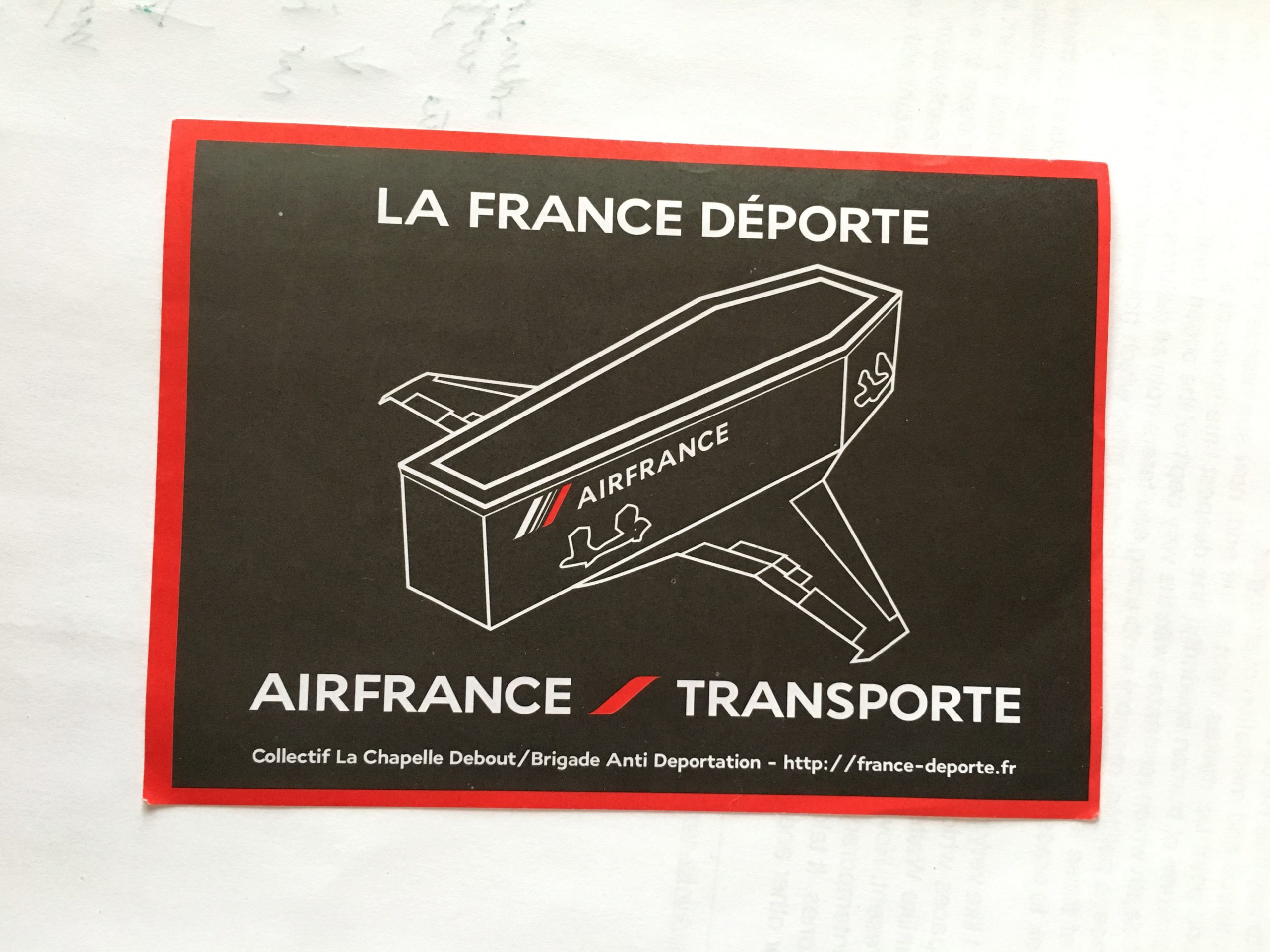
http://www.antiatlas-journal.net/pdf/antiatlas-journal-05-walters-lecadet-parizot-air-deportation-in-visibility-power-and-resistance.pdf


